Birdfinding.info ⇒ Locally common in parts of the Sahel, eastern Africa, the eastern Arabian Peninsula, and India. Areas where it is especially common include: northwestern Senegal (Ndiaël Wildlife Reserve); central Ethiopia (Aledeghi Wildlife Reserve and Awash National Park); central Kenya (Samburu and Shaba National Reserves); northern Tanzania (Ngorongoro, Serengeti and Tarangire National Parks); coastal U.A.E. (Abu Dhabi to Dubai); southern Oman (Salalah); and many sites in India, including all of Gujarat, northwestern Rajasthan, Sultanpur National Park (near New Delhi), Mayureshwar Wildlife Sanctuary (near Mumbai), Manslapur Lake in Karnataka, Rollapadu Bird Sanctuary in Andhra Pradesh, and Coimbatore and Koonthakulam Bird Sanctuary in Kerala. On Hawaii’s Big Island, it is found most readily at Waikoloa, and less so on the Waimea Plains.
Chestnut-bellied Sandgrouse
Pterocles exustus
Family: Pteroclidae
Sahelian Africa to the Indian subcontinent, in deserts, savannas, barren plains, and arid scrub.
In Africa, occurs in a band across the Sahel from southern Mauritania south to Guinea-Bissau east to Sudan, Ethiopia, and Somalia; in eastern Africa also ranges north to northern Egypt and south to central Tanzania.
On the Arabian Peninsula: may occur nearly throughout, but mainly known from near-coastal regions, in the west north to Medina, and in the east north to Kuwait.
In Asia, from southern Iran (Hormuz area) east across southern Pakistan and most of India south of the Himalayas, east to Uttar Pradesh and Chhattisgarh (sporadically to Bihar and West Bengal), and south to Kerala.
An introduced population is well-established on the dry northwestern plains of Hawaii’s Big Island—the result of a Hawaii Department of Fish & Game introduction program in the early 1960s.
Identification
Among the most “typical” of sandgrouse. Pin-tailed and largely sand-colored overall, with a dark chestnut belly. Males have a simple pattern, while females are intricately patterned.

Chestnut-bellied Sandgrouse, female and male. (Kachchh, Gujarat, India; December 23, 2018.) © Bhaarat Vyas
Male has mostly pale, sand-colored upperparts, with subtle shading that conveys a scaled appearance on the wings and back, and four to six narrow dark bars on the wing-coverts.
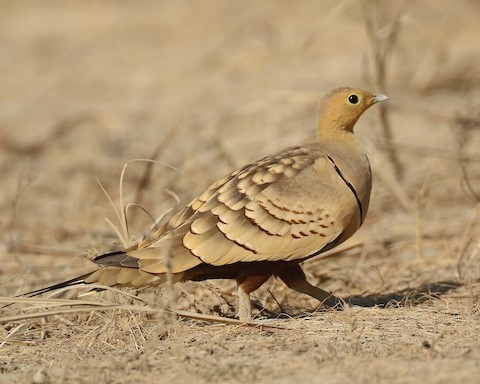
Chestnut-bellied Sandgrouse, male. (Banni Grassland, Kachchh, Gujarat, India; December 19, 2017.) © Savio Fonseca
The male’s face, or entire head and neck, usually has a distinctly orange tone.
The male’s breast is sandy with a narrow black breastband, and the belly is chestnut.
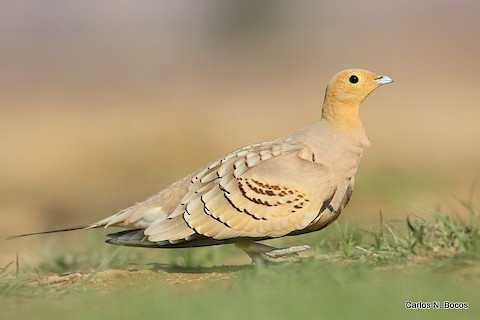
Chestnut-bellied Sandgrouse, male with pale, sandy-yellow upperparts and orange tones in the head and neck—note narrow, dark bars on wing-coverts. (Salalah, Dhofar, Oman; December 12, 2016.) © Carlos N. Bocos
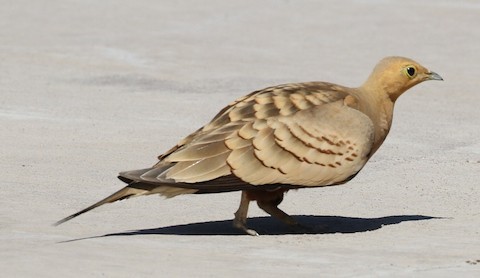
Chestnut-bellied Sandgrouse, male. (Waikoloa, Big Island, Hawaii; January 30, 2017.) © Don Coons

Chestnut-bellied Sandgrouse, male and female. (Amboseli National Park, Kenya; April 3, 2013.) © Anthony Villaume

Chestnut-bellied Sandgrouse, male showing sandy-scaly upperparts with orange tones in the head and neck. (Kachchh, Gujarat, India; January 28, 2009.) © James Holmes

Chestnut-bellied Sandgrouse, male with pale, sandy-yellow upperparts and orange tones in the head and neck—note narrow, dark bars on wing-coverts. (Amboseli National Park, Kenya; April 3, 2013.) © Anthony Villaume

Chestnut-bellied Sandgrouse, male, frontal view. (Bhutnal Kere, Bijapur, Bijapur, Karnataka, India; June 26, 2018.) © Kavi Nanda
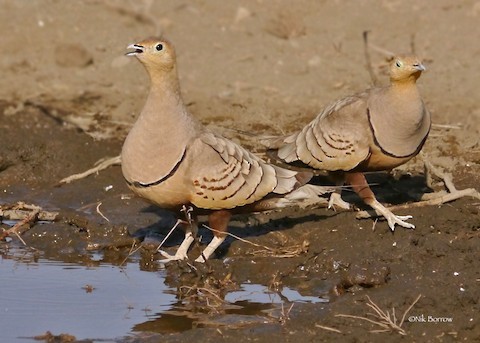
Chestnut-bellied Sandgrouse, males showing pinkish sandy plumage with narrow, blackish breast-band. (Lark Plains, Arusha, Tanzania; October 5, 2012.) © Nik Borrow
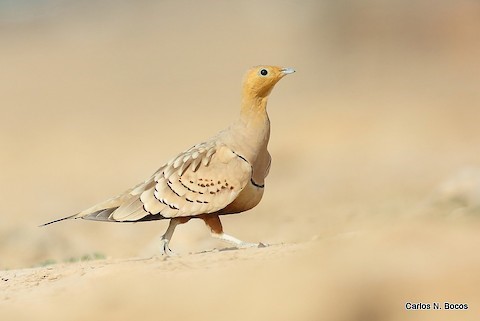
Chestnut-bellied Sandgrouse, male blending into yellow sand. (Salalah, Dhofar, Oman; December 9, 2016.) © Carlos N. Bocos

Chestnut-bellied Sandgrouse, male with contrasty upperparts. (Amboseli National Park, Kenya; January 20, 2019.) © Stephen Wainer
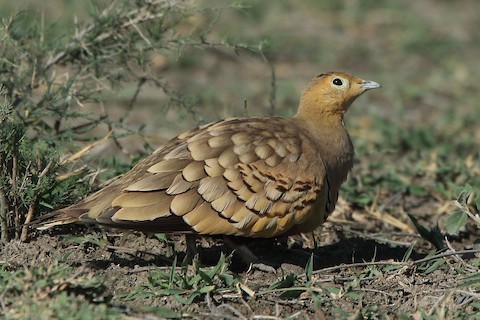
Chestnut-bellied Sandgrouse, male with darker, more olive plumage than most. (Serengeti National Park, Tanzania; December 10, 2017.) © Tadeusz Rosinski
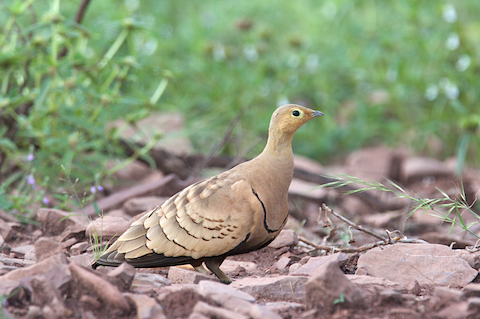
Chestnut-bellied Sandgrouse, male showing strong contrast between palle upperparts and dark underparts. (Rollapadu Wildlife Sanctuary, Kurnool, Andhra Pradesh, India; October 14, 2017.) © Ashis Kumar Pradhan

Chestnut-bellied Sandgrouse, male with rich, rusty coloration. (Bijnor South, Lucknow, Uttar Pradesh, India; February 24, 2017.) © Able Lawrence
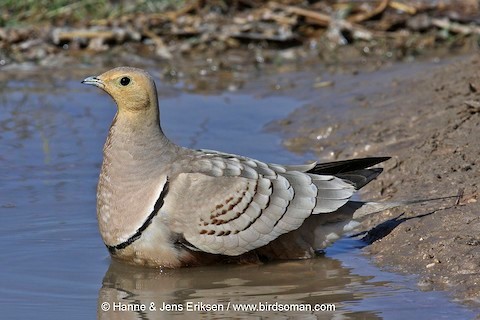
Chestnut-bellied Sandgrouse, male with grayish upperparts, and showing narrow, blackish breast-band. (Tudho, Dhofar, Oman; March 28, 2008.) © Hanne & Jens Eriksen
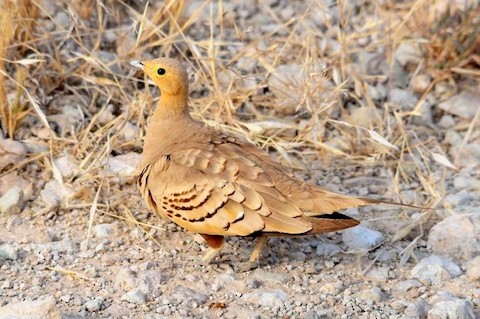
Chestnut-bellied Sandgrouse, male with mostly yellowish plumage. (Buffalo Springs National Reserve, Kenya; July 15, 2010.) © Jacques Erard

Chestnut-bellied Sandgrouse, male with brown-and-tan coloration. (Nava Talav, Little Rann of Kachchh, Surendranagar, Gujarat, India; February 26, 2019.) © Parthasarathy Gopalan
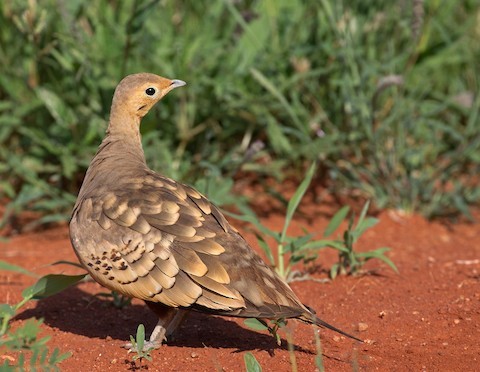
Chestnut-bellied Sandgrouse, male with brown-and-tan coloration. (Tsavo East National Park, Kenya; December 15, 2014.) © Lars Petersson

Chestnut-bellied Sandgrouse, pair mating. (Sorsan Blackbuck Sanctuary, Kota, Rajasthan, India; April 15, 2013.) © Sunil Singhal
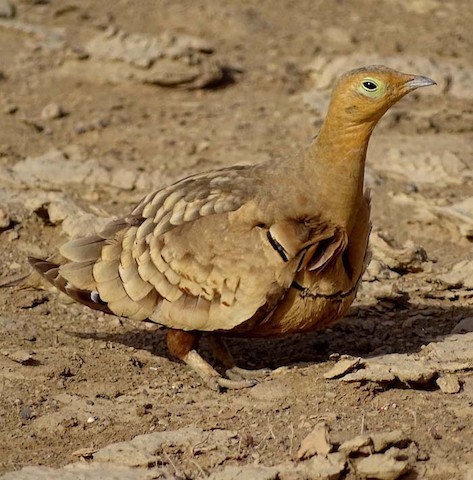
Chestnut-bellied Sandgrouse, male with remarkably orange plumage. (Banni Grasslands, Kachchh, Gujarat, India; June 8, 2016.) © Shantilal Varu
Female has heavily marked upperparts—dark-brown bars and streaks over a sandy base-color—usually with a few pale-sandy bars on the wings and spots on the back.
The female’s face is mostly unmarked, but the crown and neck are densely streaked. Often shows an orange tone on the face
The female’s underparts are much like the male’s, except that the chest is densely streaked above the narrow black breastband. The belly is densely barred, but appears all-dark under most field conditions.

Chestnut-bellied Sandgrouse, female showing dense, cryptic markings on the upperparts and chest. (Bhutnal Kere, Bijapur, Bijapur, Karnataka, India; June 26, 2018.) © Kavi Nanda
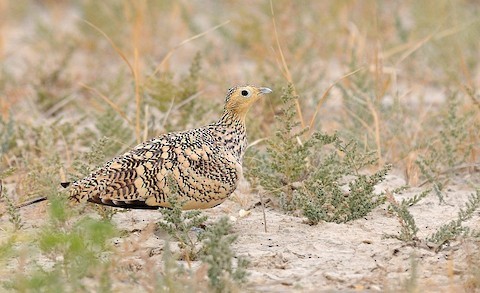
Chestnut-bellied Sandgrouse, female. (Great Rann of Kutch, Kachchh, Gujarat, India; February 1, 2014.) © Jaysukh Parekh Suman
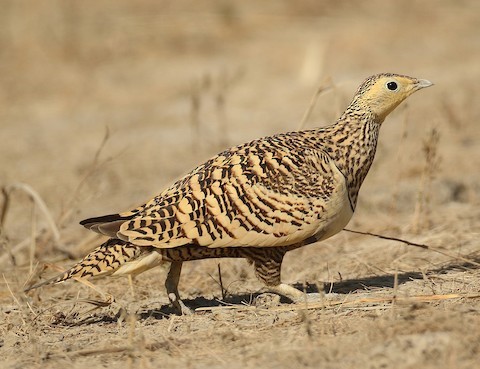
Chestnut-bellied Sandgrouse, female showing unmarked, orangey face and pale bars on the wings. (Banni Grassland, Kachchh, Gujarat, India; December 19, 2017.) © Savio Fonseca

Chestnut-bellied Sandgrouse, female. (Waikoloa, Big Island, Hawaii; September 24, 2016.) © Eric VenderWerf

Chestnut-bellied Sandgrouse, female. (Bhutnal Kere, Bijapur, Bijapur, Karnataka, India; June 26, 2018.) © Kavi Nanda
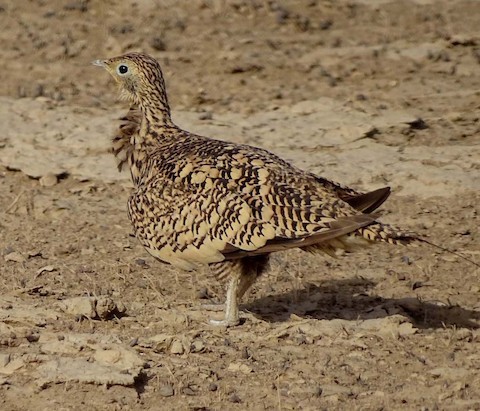
Chestnut-bellied Sandgrouse, female with dark-brown markings. (Banni Grasslands, Kachchh, Gujarat, India; June 8, 2016.) © Shantilal Varu

Chestnut-bellied Sandgrouse, female with reddish-brown markings. (Buffalo Springs National Reserve, Kenya; July 15, 2010.) © Jacques Erard
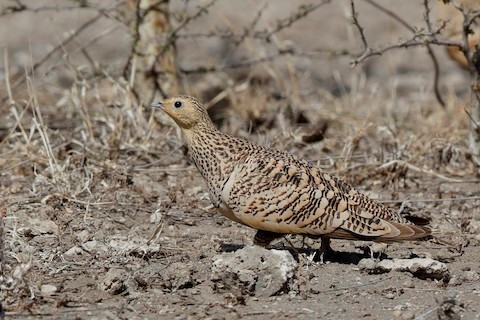
Chestnut-bellied Sandgrouse, female blending into habitat. (Abdir Lavafields, Oromia, Ethiopia; January 21, 2019.) © Holger Teichmann

Chestnut-bellied Sandgrouse, female. (Great Rann of Kutch, Kachchh, Gujarat, India; February 19, 2015.) © Marco Valentini

Chestnut-bellied Sandgrouse, female showing dense, cryptic markings on the upperparts. (Amboseli National Park, Kenya; January 20, 2019.) © Stephen Wainer
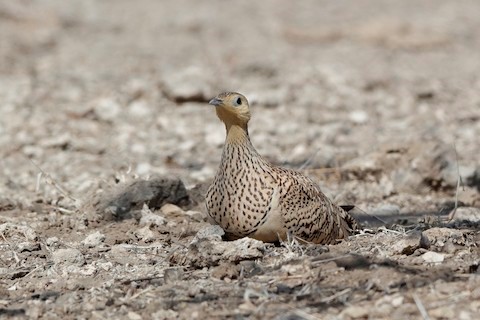
Chestnut-bellied Sandgrouse, female. (Abdir Lavafields, Oromia, Ethiopia; January 21, 2019.) © Holger Teichmann

Chestnut-bellied Sandgrouse, newly hatched, downy chick. (Banni Grasslands, Kachchh, Gujarat, India; June 8, 2016.) © Shantilal Varu
In flight, when seen from below, the overall pattern is distinctive: almost entirely dark underwings and continuously dark across the belly, with a paler head, chest, and undertail—i.e., dark from wingtip to wingtip but pale at both ends.
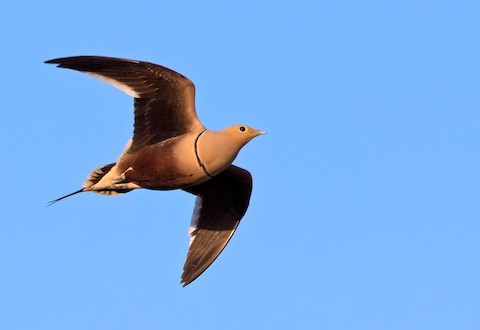
Chestnut-bellied Sandgrouse, male showing typical underside pattern: dark wings and continuously dark belly, but pale at both ends. (Desert National Park, Jaisalmer, Rajasthan, India; January 14, 2016.) © Lars Petersson
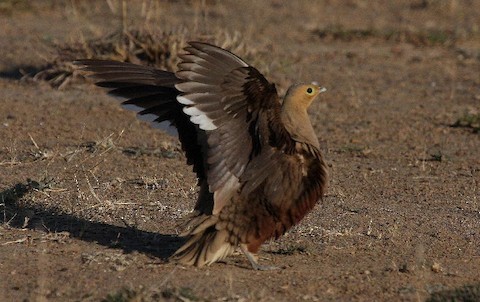
Chestnut-bellied Sandgrouse, male showing dark underwings and belly, with white trailing edge on primaries. (Great Rann of Kutch, Kachchh, Gujarat, India; February 17, 2013.) © Jugal Tiwari
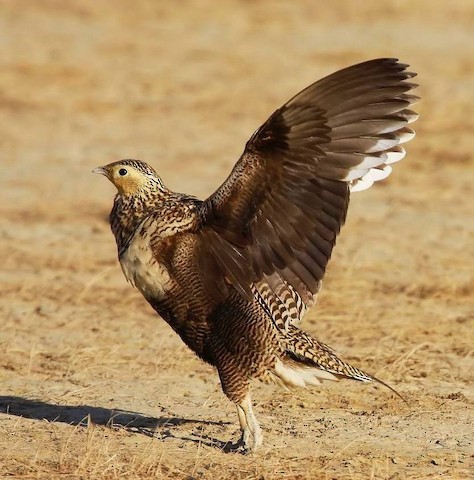
Chestnut-bellied Sandgrouse, female showing dark, barred underwings and belly, with white trailing edge on primaries. (Great Rann of Kutch, Kachchh, Gujarat, India; February 9, 2014.) © Jugal Tiwari

Chestnut-bellied Sandgrouse, flock showing underside pattern. (Aledeghi Wildlife Reserve, Afar, Ethiopia; November 17, 2007.) © Lars Petersson

Chestnut-bellied Sandgrouse, male showing dark underwing and chestnut belly, with left upperwing also visible. (Aledeghi Wildlife Reserve, Afar, Ethiopia; November 30, 2017.) © Bob Butler
If seen from above in flight, the upperparts are mostly pale, but the primaries are blackish with a contrasting white trailing edge.

Chestnut-bellied Sandgrouse, two females at left and two males at right. (Netsi Village, Jaisalmer, Rajasthan, India; December 19 2017.) © Harish Thangaraj
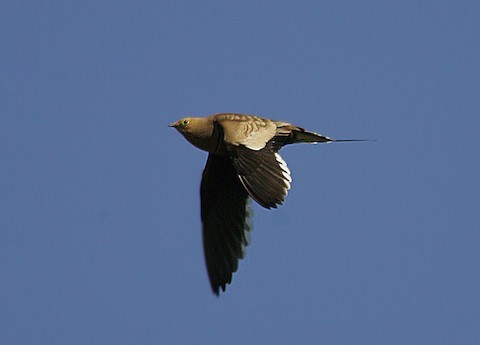
Chestnut-bellied Sandgrouse, male showing upperwing: mostly pale-sandy inner half and mostly blackish outer half with white trailing edge. (Waiki’i Ranch, Big Island, Hawaii; February 7, 2007.) © Michael Walther

Chestnut-bellied Sandgrouse, female showing upperwing: mostly pale-sandy inner half and mostly blackish outer half with white trailing edge. (Dubai Pivot Fields, Dubai, United Arab Emirates; November 6, 2010.) © Arthur Grosset
Notes
Polytypic species consisting of six recognized subspecies.
References
BirdLife International. 2018. Pterocles exustus. The IUCN Red List of Threatened Species 2018: e.T22692990A132063215. https://dx.doi.org/10.2305/IUCN.UK.2018-2.RLTS.T22692990A132063215.en. (Accessed April 20, 2020.)
de Juana, E., and P. Boesman. 2020. Chestnut-bellied Sandgrouse (Pterocles exustus). In Handbook of the Birds of the World Alive (J. del Hoyo, A. Elliott, J. Sargatal, D.A. Christie, and E. de Juana, eds.). Lynx Edicions, Barcelona. https://www.hbw.com/node/54085. (Accessed April 20, 2020.)
eBird. 2020. eBird: An online database of bird distribution and abundance. Cornell Lab of Ornithology, Ithaca, N.Y. http://www.ebird.org. (Accessed April 20, 2020.)
Hawaii Audubon Society. 2005. Hawaii’s Birds (Sixth Edition). Island Heritage Publishing, Waipahu, Hawaii.
Hollom, P.A.D., R.F. Porter, S. Christensen, and I. Willis. 1988. Birds of the Middle East and North Africa. T & AD Poyser, Calton, England.
Madge, S., and P.J.K. McGowan. 2002. Pheasants, Partridges, and Grouse: A Guide to the Pheasants, Partridges, Quails, Grouse, Guineafowl, Buttonquails, and Sandgrouse of the World. Princeton University Press, Princeton, N.J.
Pratt, H.D. 1993. Enjoying Birds in Hawaii: A Birdfinding Guide to the Fiftieth State (Second Edition). Mutual Publishing, Honolulu, Hawaii.
Pyle, R.L., and P. Pyle. 2017. The Birds of the Hawaiian Islands: Occurrence, History, Distribution, and Status. Version 2 (January 1, 2017). http://hbs.bishopmuseum.org/birds/rlp-monograph/. B.P. Bishop Museum, Honolulu, Hawaii.
van Perlo, B. 2002. Birds of Western and Central Africa. Princeton University Press, Princeton, N.J.
Xeno-Canto. 2020. Chestnut-bellied Sandgrouse – Pterocles exustus. https://www.xeno-canto.org/species/Pterocles-exustus. (Accessed April 20, 2020.)

